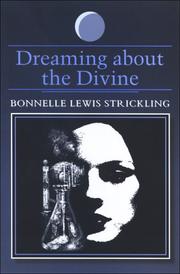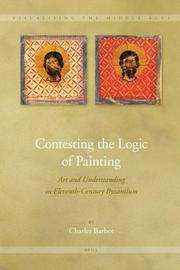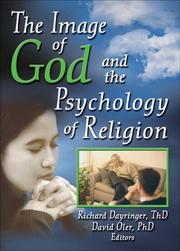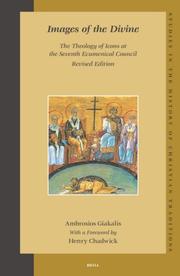| Listing 1 - 10 of 19 | << page >> |
Sort by
|
Book
ISBN: 1503604233 Year: 2020 Publisher: Stanford, CA : Stanford University Press,
Abstract | Keywords | Export | Availability | Bookmark
 Loading...
Loading...Choose an application
- Reference Manager
- EndNote
- RefWorks (Direct export to RefWorks)
Images increasingly saturate our world, making present to us what is distant or obscure. Yet the power of images also arises from what they do not make present—from a type of absence they do not dispel. Joining a growing multidisciplinary conversation that rejects an understanding of images as lifeless objects, this book offers a theological meditation on the ways images convey presence into our world. Just as Christ negates himself in order to manifest the invisible God, images, Natalie Carnes contends, negate themselves to give more than they literally or materially are. Her Christological reflections bring iconoclasm and iconophilia into productive relation, suggesting that they need not oppose one another. Investigating such images as the biblical golden calf and paintings of the Virgin Mary, Carnes explores how to distinguish between iconoclasms that maintain fidelity to their theological intentions and those that lead to visual temptation. Offering ecumenical reflections on issues that have long divided Protestant, Catholic, and Orthodox traditions, Image and Presence provokes a fundamental reconsideration of images and of the global image crises of our time.
Image (Theology) --- Jesus Christ --- Iconography. --- Presence.

ISBN: 0791480178 1429478306 9781429478304 9780791480175 0791470911 079147092X 9780791470916 9780791470923 Year: 2007 Publisher: Albany : State University of New York Press,
Abstract | Keywords | Export | Availability | Bookmark
 Loading...
Loading...Choose an application
- Reference Manager
- EndNote
- RefWorks (Direct export to RefWorks)
Explores the role of dreams in spiritual work.
Dreams --- Religious aspects. --- Image of God. --- God --- God, Image of --- Image (Theology) --- Theological anthropology --- Image
Book
ISBN: 083089960X 9780830899609 0830851208 9780830851201 9780830851201 Year: 2016 Publisher: Downers Grove, Illinois : IVP Academic,
Abstract | Keywords | Export | Availability | Bookmark
 Loading...
Loading...Choose an application
- Reference Manager
- EndNote
- RefWorks (Direct export to RefWorks)
Theological anthropology --- Image of God. --- God --- God, Image of --- Image (Theology) --- Man (Christian theology) --- Christianity. --- Image --- Image of God --- 233 --- Christianity --- De mens. Theologische antropologie
Book
ISBN: 9781481315371 1481315374 1481315390 9781481316583 1481316583 9781481315395 Year: 2021 Publisher: Waco, Texas : Baylor University Press,
Abstract | Keywords | Export | Availability | Bookmark
 Loading...
Loading...Choose an application
- Reference Manager
- EndNote
- RefWorks (Direct export to RefWorks)
A statuette of Egyptian King Pepi formidably wielding a shepherd's crook stands in stark contrast to a fresco of an unassuming Orpheus-like youth gently hoisting a sheep around his shoulders. Both images, however, occupy an extensive tradition of shepherding motifs. In the transition from ancient Near Eastern depictions of the keeper of flocks as one holding great power to the more "pastoral" scenes of early Christian art, it might appear that connotations of rulership were divested from the image of the shepherd. The reality, however, presents a much more complex tapestry. The Good Shepherd: Image, Meaning, and Power traces the visual and textual depictions of the Good Shepherd motif from its early iterations as a potent symbol of kingship, through its reimagining in biblical figures, such as the shepherd-king David, and onward to the shepherds of Greco-Roman literature. Jennifer Awes Freeman reveals that the figure of the Good Shepherd never became humble or docile but always carried connotations of empire, divinity, and defensive violence even within varied sociopolitical contexts. The early Christian invocation of the Good Shepherd was not simply anti-imperial but relied on a complex set of associations that included king, priest, pastor, and sacrificial victim--even as it subverted those meanings in the figure of Jesus, both shepherd and sacrificial lamb. The concept of the Good Shepherd continued to prove useful for early medieval rulers, such as Charlemagne, but its imperial references waned in the later Middle Ages as it became more exclusively applied to church leaders. Drawing on a range of sources including literature, theological treatises, and political texts, as well as sculpture, mosaics, and manuscript illuminations, The Good Shepherd offers a significant contribution as the first comprehensive study of the long history of the Good Shepherd motif. It also engages the flexible and multivalent abilities of visual and textual symbols to convey multiple meanings in religious and political contexts.
Iconography --- iconography --- religious art --- Bible stories --- Jesus Christ --- Shepherds in art --- Christian art and symbolism --- Image (Theology) --- History --- Art. --- Christian art and symbolism. --- History. --- Jesus Christ. --- Jezus

ISBN: 9789004162716 9004162712 9786611939892 1281939897 9047431618 9789047431619 9781281939890 661193989X Year: 2007 Volume: 2 Publisher: Leiden ; Boston : Brill,
Abstract | Keywords | Export | Availability | Bookmark
 Loading...
Loading...Choose an application
- Reference Manager
- EndNote
- RefWorks (Direct export to RefWorks)
Studies of the icon in Byzantium have tended to focus on the iconoclastic era of the eighth- and ninth-centuries. This study shows that discussion of the icon was far from settled by this lengthy dispute. While the theory of the icon in Byzantium was governed by a logical understanding that had limited painting to the visible alone, the four authors addressed in this book struggled with this constraint. Symeon the New Theologian, driven by a desire for divine vision, chose, effectively, to disregard the icon. Michael Psellos used a profound neoplatonism to examine the relationship between an icon and miracles. Eustratios of Nicaea followed the logic of painting to the point at which he could clarify a distinction between painting from theology. Leo of Chalcedon attempted to describe a formal presence in the divine portrait of Christ. All told, these authors open perspectives on the icon that enrich and expand our own modernist understanding of this crucial medium.
Icons, Byzantine. --- Image (Theology) --- Theologians --- Icônes byzantines --- Image (Théologie) --- Théologiens --- Byzantine Empire --- Empire byzantin --- Church history. --- Histoire religieuse --- Christian art and symbolism --- Communication --- Byzantine icons --- Religious aspects --- Christianity

ISBN: 0789027615 0789027607 0203051181 1136434445 1299459994 9781136434440 9780203051184 9781136434518 9781136434587 9780789027603 9780789027610 1136434518 Year: 2004 Publisher: Binghamton, N.Y. : Haworth Press,
Abstract | Keywords | Export | Availability | Bookmark
 Loading...
Loading...Choose an application
- Reference Manager
- EndNote
- RefWorks (Direct export to RefWorks)
What are the implications of a client's image of God?Improve your confidence?and your practice skills?by enhancing your knowledge of how individuals are likely to perceive God, and of how those perceptions impact the way they function as human beings. Theologians have long speculated and theorized about how humans imagine God to be. This book merges theology with science, presenting empirical research focused on perceptions of God in a variety of populations living in community and mental health settings. Each chapter concludes with references that comprise an essential reading lis
God (Christianity) --- Image of God. --- Pastoral counseling. --- Care of souls --- Counseling, Pastoral --- Cure of souls --- Counseling --- Pastoral psychology --- Pastoral care --- Spiritual direction --- God --- God, Image of --- Image (Theology) --- Theological anthropology --- Christianity --- Trinity --- Religious aspects --- Image
Book
ISBN: 3897858673 9783897858671 9783897853218 3897853213 1336026634 Year: 2013 Publisher: Paderborn : mentis,
Abstract | Keywords | Export | Availability | Bookmark
 Loading...
Loading...Choose an application
- Reference Manager
- EndNote
- RefWorks (Direct export to RefWorks)
Die Aufsätze dieses Bandes zeichnen den Weg der neuzeitlichen Philosophie zu einer autonomen Ethik nach, die von religiösen Lehren und naturalistischen Annahmen der Wissenschaft gleichermaßen unabhängig ist. Diese Ethik bedarf aber der Erneuerung von Wertbegriffen der Natur, wenn sie Kriterien für die technische Naturbeherrschung und den richtigen Umgang mit dem menschlichen Körper entwickeln will. Die Aufsätze prüfen, wie weit die philosophische Ethik von den Begriffen der antiken Philosophie (kosmos, physis) und der christlichen Tradition (Schöpfung, Versöhnung) noch lernen kann. Aus einer Erneuerung dieser Begriffe, die mit den modernen Biowissenschaften zusammenpasst, werden Stellungnahmen zu biotechnischen und medizintechnischen Problemen entwickelt. Dabei geht es vor allem um die Technisierung der lebendigen Natur, die Verbesserung des Menschen und die technischen Optionen am Beginn und Ende des menschlichen Lebens.
Ethics. --- Image of God. --- PHILOSOPHY --- God --- God, Image of --- Image (Theology) --- Theological anthropology --- Deontology --- Ethics, Primitive --- Ethology --- Moral philosophy --- Morality --- Morals --- Philosophy, Moral --- Science, Moral --- Philosophy --- Values --- Mental philosophy --- Humanities --- Essays. --- Reference. --- Image
Book
ISBN: 1498239102 9781498239103 1498239110 9781498239110 9781498239097 1498239099 Year: 2016 Publisher: Eugene, Oregon : Cascade Books,
Abstract | Keywords | Export | Availability | Bookmark
 Loading...
Loading...Choose an application
- Reference Manager
- EndNote
- RefWorks (Direct export to RefWorks)
Globalization has raised numerous questions about theology and culture for Christians. How should we respond to outsourcing and immigration? How does anti-Western sentiment affect the proclamation of the gospel? What is the role of the church in society? This book argues that Christians will be most fulfilled and most effective if they embrace their cultural activity rather than feel ambivalent about it. The central question of this book is, how does bearing God's image relate to cultural activity? Nehrbass explains that "spheres of culture," such as political, technological, and social structures, are systems that God has instilled in humans as his image bearers, so that they can glorify and enjoy him forever. Therefore, a theology of culture involves recognizing that the kingdom of God encompasses heaven and Earth, rather than pitting heaven against Earth. The text surveys anthropological explanations for humanity's dependence on culture, and shows that each explanation provides only partial explanatory scope. The most satisfying explanation is that a major functional aspect of bearing God's image is engaging in culture, since the Trinity has been eternally engaged in cultural functions like ruling, communicating, and creating. Each chapter contains a summary and questions about what it means to be a world-changer in the twenty-first century. --
Christianity and culture. --- Multiculturalism --- Image of God. --- God --- God, Image of --- Image (Theology) --- Theological anthropology --- Contextualization (Christian theology) --- Culture and Christianity --- Inculturation (Christian theology) --- Indigenization (Christian theology) --- Culture --- Religious aspects --- Christianity. --- Image
Book
ISBN: 9780198816775 0198816774 0191858374 0192548727 0192548735 Year: 2018 Publisher: Oxford : Oxford University Press,
Abstract | Keywords | Export | Availability | Bookmark
 Loading...
Loading...Choose an application
- Reference Manager
- EndNote
- RefWorks (Direct export to RefWorks)
This title provides an investigation of the icon-theology of St Theodore the Studite, mainly as it is presented in his three refutations of the iconoclasts, the Antirrhetici tres adversus iconomachos. Torstein Theodor Tollefsen explores Theodore's 'philosophy of images', namely his doctrine of images and his arguments that justify the legitimacy of images in general and of Christ in particular. Tollefsen offers a historical, theological, and philosophical exploration of Theodore's doctrine of images and his arguments justifying the legitimacy of images and of Christ.
235.3 THEODORUS STUDITA --- 235.3 THEODORUS STUDITA Hagiografie--THEODORUS STUDITA --- 235.3 THEODORUS STUDITA Hagiographie--THEODORUS STUDITA --- Hagiografie--THEODORUS STUDITA --- Hagiographie--THEODORUS STUDITA --- Iconoclasm --- Icons --- Image (Theology) --- Cult --- History of doctrines --- Theodore, --- Iconoclasm - Europe - To 1500 --- Icons - Cult - Byzantine Empire - Early works to 1800 --- Image (Theology) - History of doctrines - Middle Ages, 600-1500 --- Theodorus Studita --- Iconoclasme --- Theodore, - Studites, Saint, - 759-826. - Antirrheticus adversus iconomachos --- History --- Idols and images --- Worship --- Feodor, --- Teodor Studyta, --- Teodoro, Estudita, --- Teodoro, --- Theodor, --- Theodōros, --- Theodorus Studita, --- Феодор,

ISBN: 9004143289 9789004143289 9781429452915 1429452919 1280867868 9786610867868 9047407288 1433705087 9789047407287 Year: 2005 Publisher: Leiden ; Boston : Brill,
Abstract | Keywords | Export | Availability | Bookmark
 Loading...
Loading...Choose an application
- Reference Manager
- EndNote
- RefWorks (Direct export to RefWorks)
This book, newly revised and updated, examines the Eastern Church's theology of icons chiefly on the basis of the acta of the Seventh Ecumenical Council of 787. The political circumstances leading to the outbreak of the iconclast controversy in the eighth century are discussed in detail, but the main emphasis is on the theological arguments and assumptions of the council participants. Major themes include the nature of tradition, the relationship between image and reality, and the place of christology. Ultimately the argument over icons was about the accessibility of the divine. Icons were held by the iconophiles to communicate a deifying grace which raised the believer to participation in the life of God.
Orthodox Eastern Church --- Doctrines --- Council of Nicaea (2nd : 787) --- Icons --- Cult --- History of doctrines --- Middle Ages, 500-1500 --- Image (Theology) --- Iconoclasm --- Iconoclasm. --- Idols and images --- Christian art and symbolism --- Communication --- Eikons --- Ikons --- Christian saints in art --- History --- Worship --- Religious aspects --- Christianity --- Doctrines. --- Council of Nicaea --- Concilio niceno --- Convegno niceno --- Council of Nicaea, --- Konzil von Nizäa
| Listing 1 - 10 of 19 | << page >> |
Sort by
|

 Search
Search Feedback
Feedback About UniCat
About UniCat  Help
Help News
News